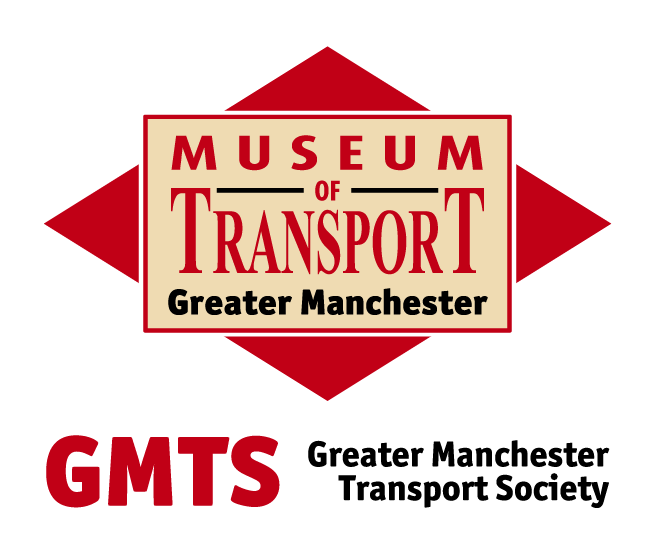1969 Stockport Corporation lays the foundation stone of its new garage at Daw Bank (7 January).
1969 Lancashire United Transport opens its new Sports & Social Club at Atherton Garage (23 January)
1969 Stockport Corporation receives the last front engined, rear entrance bus for use in the UK.
1969 SELNEC Passenger Transport Authority (PTA) is established (1 April).
1969 SELNEC Passenger Transport Executive (PTE) is established (1 September).
1969 The operations of the 11 council run transport departments in the SELNEC area are handed over to SELNEC. This includes 2,526 buses and assets valued at £21,800,000 (1 November).
1969 The last traditional half cab bus for the UK market is delivered to SELNEC, having been ordered by Ramsbottom UDC.
1969 SELNEC enters into running agreements with North Western on joint routes.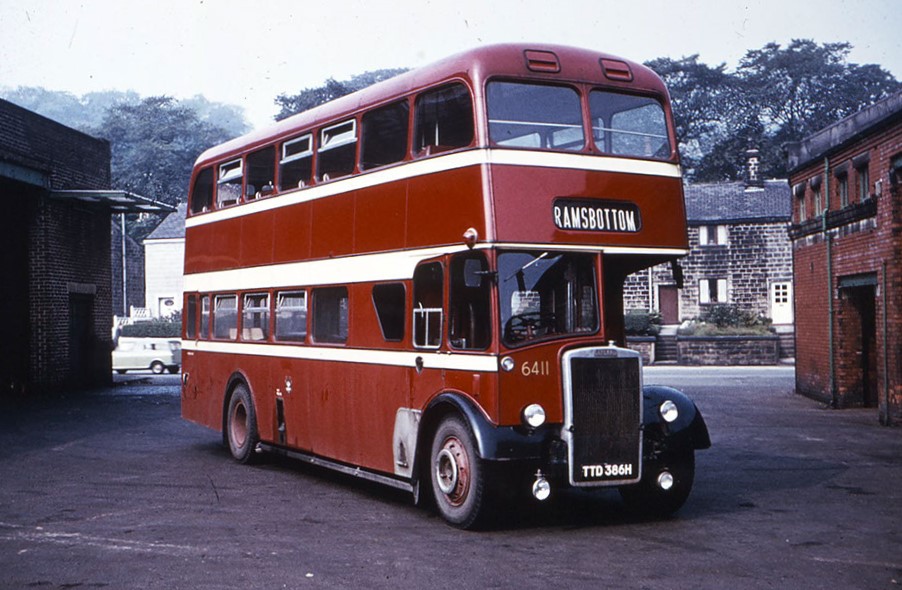
SELNEC takes delivery of the last traditional half cab bus in the UK, ordered by Ramsbottom UDC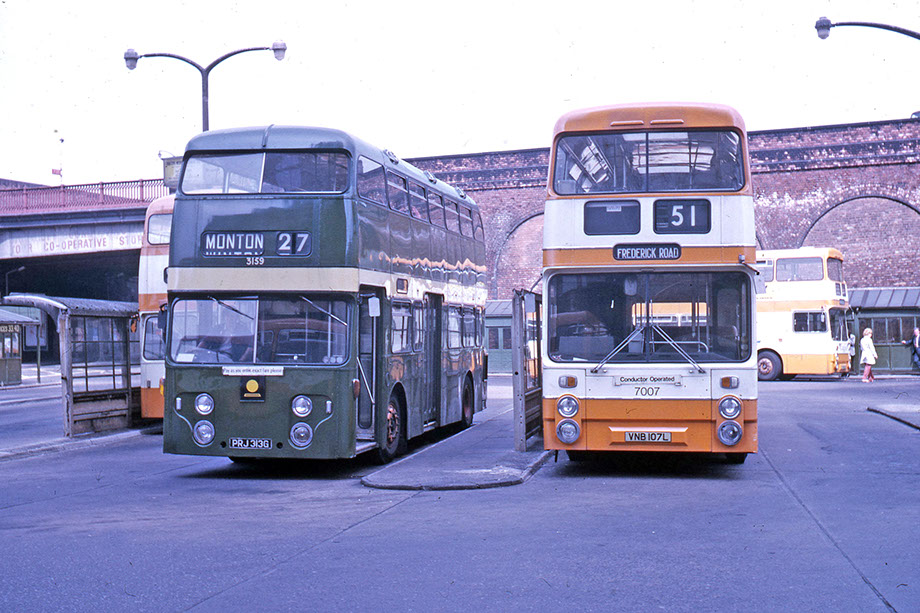
All change: in with the new orange and white livery, out with the old! Changing scenes at Victoria Bus Station in Salford
1970 SELNEC introduces a new livery for its buses of orange and white.
1970 The first computers are used for the creation of schedules and duty rosters for drivers and conductors.
1970 The first experimental standard SELNEC double deck bus is placed on display at the Commercial Motor Show (September).
1970 27% of total route mileage is now one-man operated.
1970 Plans are prepared for a new underground railway between Victoria and Piccadilly stations running under central Manchester, allowing passengers to travel by rail from one side of the city to the other for the first time (Picc-Vic).
1970 A working agreement with SELNEC regarding joint services is reached with LUT.
1971 SELNEC is restructured with its divisions becoming companies (1 March).
1971 One Man Operation now accounts for 47% of service mileage.
1971 Former Manchester Corporation garage at Parrs Wood closes.
1971 Half-fare travel concessions are introduced for the elderly, restricted to off-peak hours only.
1972 Concessionary passes for the elderly can now be used at all times, seven days a week (1 Jan).
1972 Local Government Act which will create metropolitan counties and districts in 1974.
1972 The North Western Road Car Company operations in SELNEC area absorbed into SELNEC, becoming SELNEC Cheshire (3 March).
1972 The first bus lane in Greater Manchester opens on London Road.
1972 Parliamentary powers are obtained for the Piccadilly/Victoria Tunnel (Picc-Vic).
1972 The school leaving age is increased to 16.
1972 Radio links are established with inspectors to help control buses.
1972 The first 200 SELNEC standard buses are delivered after development work between engineers, manufacturers and body builders result in a standard SELNEC specification for its buses.
1972 Developmental work takes place for an electrically powered bus.
1972 57% of the fleet is now suitable for one-man operation.
1972 SELNEC becomes first PTE to sign an agreement with British Rail allowing it to determine the frequencies, fares and standards of local passenger rail services within the area (11 December).
1973 Lancashire United Transport (LUT) introduces 'Videmat' self service ticket machines which produce tickets printed with an image of the coins inserted into the machine to pay each fare (23 July).
1973 Concessionary travel is extended to rail travel for elderly persons and school children.
1973 Introduction of the "hush bus", which has a noise level significantly lower than other buses, is introduced.
1973 The cost of diesel fuel increases significantly due to the oil crisis.
1973 Oldham (Clegg Street), Urmston and part of Stockport (Charles Street) garages all close (all former North Western garages).
1974 150th anniversary of public transport in Greater Manchester, marked by special events.
1974 The first SELNEC electric bus is demonstrated (Silent Rider) - its batteries weigh 4 tons! (4 March).
1974 Local Government Reorganisation (1 April): Greater Manchester Council (GMC) established and Greater Manchester Metropolitan County formed, including Wigan.
1974 The role of the Passenger Transport Authority is transferred to Greater Manchester County Council and SELNEC becomes Greater Manchester Transport, incorporating Wigan Corporation Transport.
1974 The Greater Manchester Transport 'M' logo is introduced.
1974 A flat concessionary fare for the elderly and children in Greater Manchester is introduced (1st April).
1974 The Centreline service is introduced, linking Manchester Victoria with Manchester Piccadilly is introduced (1 July).
1974 Dial-a-Ride Limited launches an extensive demand responsive transport system in Sale.
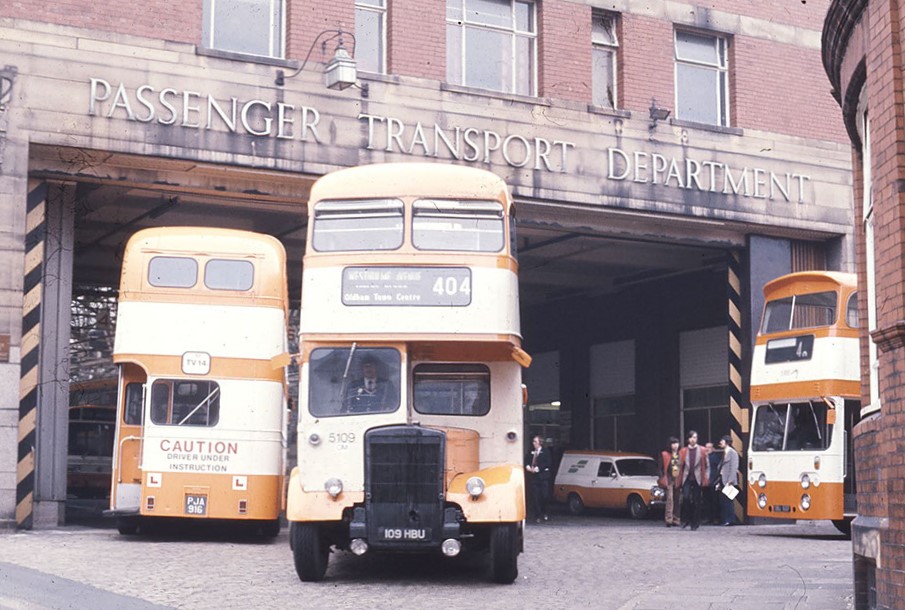
A busy scene outside Oldham Garage: in four years much of the fleet had ended up in the new colours
1975 Greater Manchester Transport’s second electric bus (Lucas Electric Bus) is delivered with a top speed of 45mph. It can run for a 12 hour duty, can cover 40 miles between charges and its batteries weigh 2 tons. It can carry a full load of 34 passengers and accelerate from 0 to 30 in 15 seconds. (January).
1975 GMT starts the conversion to Almex ticket machines, to standardise ticket issuing (April).
1975 The SaverSeven weekly ticket is launched giving unlimited bus travel within Greater Manchester.
1975 69% of the fleet is now suitable for one man operation.
1975 Over a third all buses in the fleet have been equipped with radios, including all buses used on night services.
1975 'Bus News', detailing bus/rail service alterations and traffic delays is launched on BBC Radio Manchester.
1975 The Lucas Electric Bus travels non-stop from Manchester to Birmingham at 27mph – at the time the longest distance ever travelled by an electric bus in one go.
1975 Silent Rider operates on rush hour services. With a top speed of 40mph, it has 41 seats, can run for 40 miles between charges and can be fully recharged in 3 hours.
1975 Greater Manchester Transport purchases the operations of Warburton’s of Tottington (November)
1976 Greater Manchester Transport acquires Lancashire United Transport, but it remains separate (1 January).
1976 The 'Picc-Vic' project is cancelled.
1976 SELNEC Parcels, the successor to Manchester Corporation’s parcel services, closes.
1976 Charterplan coach unit is launched.
1976 SaverSeven is extended to include all rail travel in Greater Manchester.
1976 Altrincham Interchange, the first purpose built bus and rail interchange in Greater Manchester, opens (1 November).
1976 Greater Manchester Transport acquires Godfrey Abbott (1 November).
1977 New Whitefield Bus Station opens.
1977 The first new railway station is opened by Greater Manchester Transport at Brinnington near Stockport. This is the first new station to be opened in Greater Manchester since 1938.
1977 Silent Rider is demonstrated in Chicago at the World’s first International Electric Vehicle Exposition.
1977 Work starts on preparing the original Queens Road bus garage in Manchester as the Museum of Transport.
1978 Greater Manchester Transport’s Tameside Garage opens, designed to accommodate 150 buses (February).
1978 Rochdale Bus Station is officially opened (16 May).
1979 Official opening of the Museum of Transport (4 May).
1979 Greater Manchester Transport's new Training Department at Bennett Street opens (23 May) and a new livery of yellow and white is introduced for its training buses (June).
1979 Manchester Arndale Bus Station opens (24 September).
1979 The new Eccles Bus Station opens (September).
1979 British Rail receives Parliamentary powers for the ‘Castlefield Curve’ – the plans are later cancelled.
1979 GMT opens Bolton Garage (Crook Street), designed to hold 220 buses (October).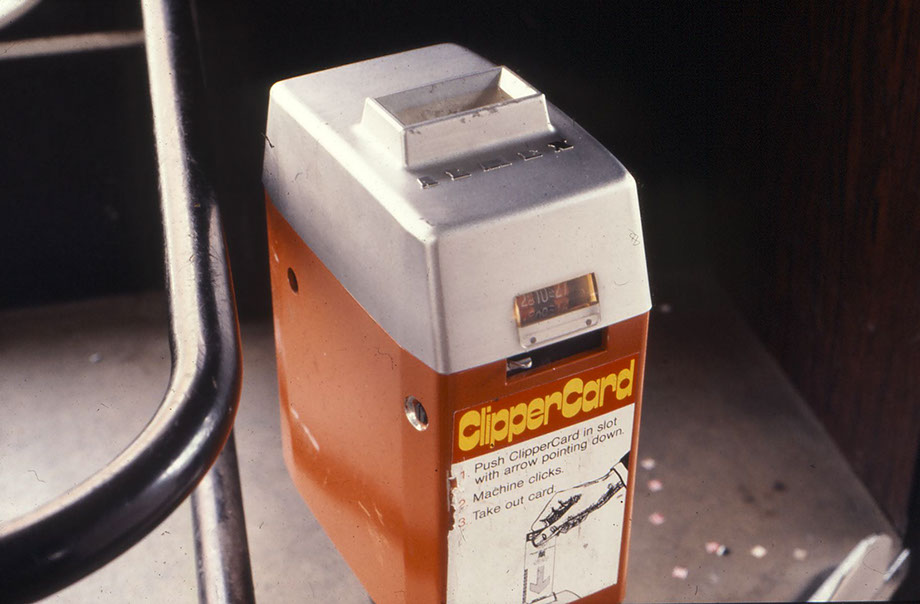
1979 The ClipperCard 10 trip bus ticket is launched (November).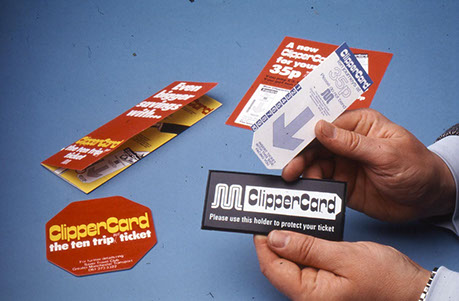
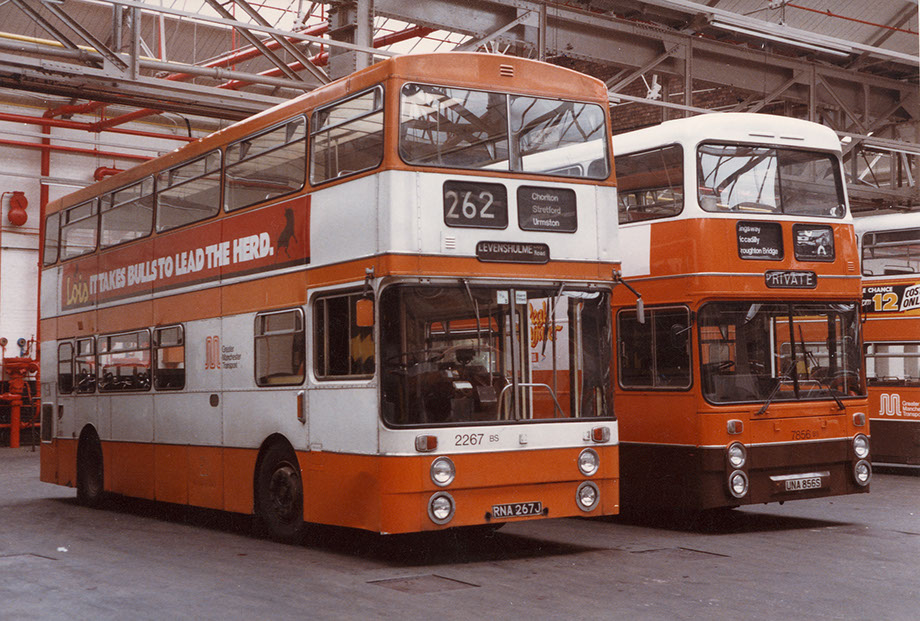
Livery change time again: 2267 in the original orange and white livery and 7856 in the new livery
1980 Heaton Park Tramway is officially opened (28 March).
1980 The new Bury bus and rail interchange becomes operational, it is officially opened by Princess Alexandra (9th July).
1980 Phases 1 and 2 of the new Stockport bus station are opened.
1980 Shop-n-Save and Teentravel ClipperCards are introduced.
1981 New bus stations open: Oldham Town Square (January), Oldham Clegg Street, Southern Cemetery, and Wythenshawe (December). Stockport bus station is completed.
1981 Bus fares are frozen.
1981 One man operated buses now cover over 90% of Greater Manchester Transport’s bus services.
1981 A new livery is introduced for the bus fleet: white, orange and brown (summer).
1981 The Hazel Grove rail electrification scheme is completed (1 June).
1981 The Concessionary ClipperCard is introduced.
1981 Lancashire United Transport is absorbed into Greater Manchester Transport and the LUT name disappears from buses.
1981 GMT completes Altrincham Garage, designed to house 80 buses (June).
1982 Bus fares unfrozen which leads to significant fare increases.
1982 The Saver Monthly is introduced.
1982 Sunday Rover day ticket introduced to encourage use of buses on Sundays.
1982 Pope John Paul II visits Manchester - 1,000 buses are used to transport people to Heaton Park.
1982 Peak Wayfarer ticket giving cheaper access to leisure destinations in North Cheshire and the Peak District is introduced.
1982 Working hours for drivers, conductors and catering staff are reduced from 40 to 39 on a 'without loss of pay' basis.
1983 The Teen Travel ClipperCard is extended for use by all 16-19 year olds.
1983 The first and second stages of the reconstructed Ashton-under-Lyne Bus Station are opened (February).
1983 Middleton Bus Station improvements are completed (June).
1983 The working week for inspectors and traffic staff is reduced from 39 to 38 hours.
1983 Bus services are provided free of charge on 25th and 26th December.
1984 Manchester Airport Bus Station is officially opened (1 March).
1984 The reconstruction of Radcliffe bus station is completed (April).
1984 The age at which children can travel free on buses is raised from 3 to 5 years.
1984 The first Bill seeking permission to build Metrolink is submitted to Parliament.
1984 The last Manchester Corporation designed ‘Mancunian’ bus operates (13 November).
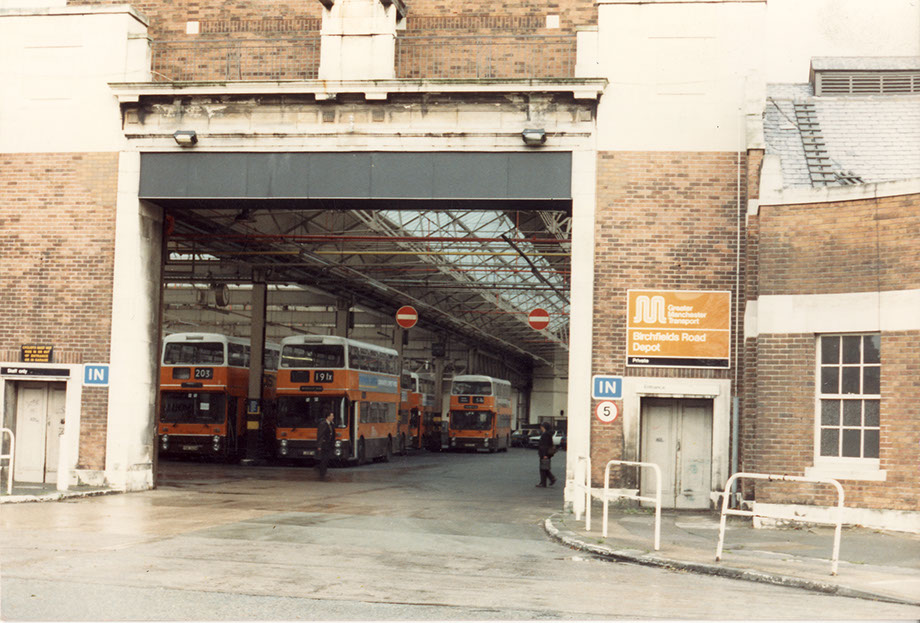
A typical scene as you go past the entrance of the former Manchester Corporation Birchfields Road Garage
1985 Post Offices begin to sell SaverSeven and ClipperCard pre-purchased bus tickets.
1985 'Localine' bus service scheme for the mobility impaired starts operating in Wythenshawe.
1985 GMT officially opens the new Bury Garage (August).
1985 The first Ring and Ride bus service for the mobility impaired is established in Manchester (September).
1985 To promote the use of ClipperCards and Saver tickets, television advertising is used for the first time: 'They cut the fares, they cut the fuss'.
1985 Local Government Act 1985: abolition of metropolitan county councils.
1985 Transport Act 1985: bus service deregulation which will bring about changes as great as those seen in the 1930s and the transfer of Passenger Transport Executive bus operations to companies owned by Passenger Transport Authorities (30 October).
1985 A shadow joint board Passenger Transport Authority is established for Greater Manchester.
1985 Yelloway Motor Services is sold.
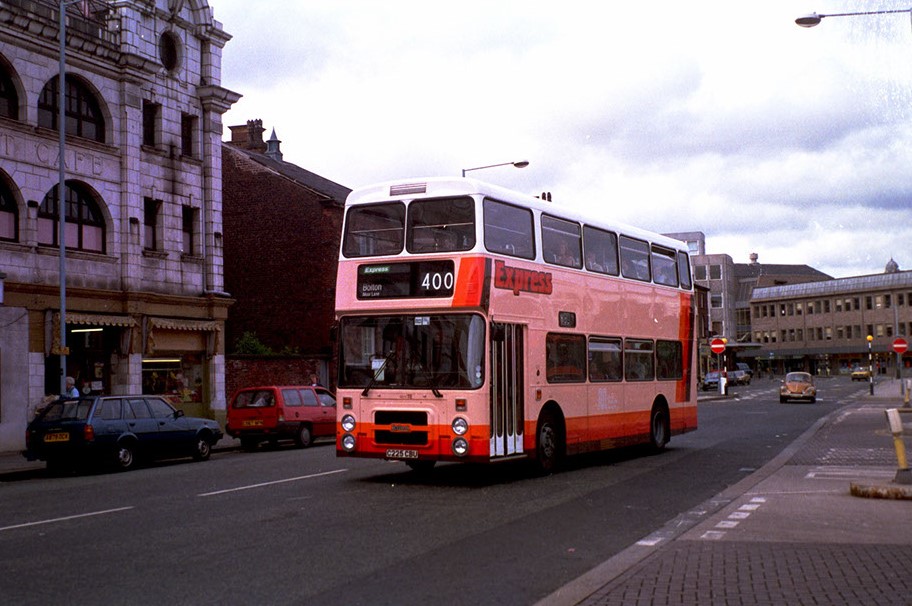
New striking Express livery introduced, seen on Haymarket Street, Bury just outside the Interchange
